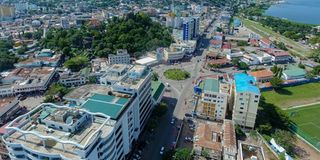Exploring Mwanza: A journey through Tanzania’s ‘Rock City’

What you need to know:
- Mwanza serves as a commercial hub for up to seven regions and connects four neighbouring countries. That has significantly been amplifying Mwanza’s prospects, leading to its development. No wonder the city has been expanding rapidly – ranked as one of the 15 fastest-growing cities in the world by WEF.
The vibrant city of Mwanza has long captured my attention. I have been following the stories of its development for years, but the opportunities to visit were few. That all ended lately when I spent a week in that dynamic city.
Mwanza’s existence is intricately linked to its geography. More than half of the region is covered by water. Lake Victoria, on whose shores the city is located, influences Mwanza’s history, climate, and socioeconomic activities, underscoring its pivotal role in the city’s existence.
While the region is generally flat, Mwanza boasts numerous hills adorned with granite rocks strewn about, earning it the nickname ‘the Rock City.’ This distinctive feature sets Mwanza apart, creating a characteristic landscape found nowhere else.
After a 15-year hiatus, my rediscovery of Mwanza began with a bodaboda tour guided by Phares, an extraordinary rider with a teaching certificate and three years of JKT experience. His disciplined approach and intimate knowledge of the city added a unique dimension to my experience.
Once Phares understood what I needed, he became an absolute delight, orchestrating visits to hidden gems. The trips to Capri Point and Jiwe Kuu stood out – thanks to the breathtaking views of the city and the lake possible from those vantage points.
During the trip to Bugando Medical Centre, I was relieved to see roads made up of stones, highlighting the potential for sustainable construction using local materials. I hope that Mwanza will take construction using local stones to another level: if you are the Rock City, why not become the most badass rock city in the world?
Many of Mwanza’s residents are fond of building houses around the rocky hills. Unfortunately, many houses are low in quality, thus detracting from rather than improving the landscape. Reviewing the colourful favelas in Sao Paulo and Rio de Janeiro might offer some inspiration. Mwanza possesses significant tourism potential, therefore, it’s vital to maintain and improve its natural beauty.
From Mwanza, I made trips to Bulyanhulu in Geita and Majita in Musoma. Mwanza serves as a commercial hub for up to seven regions and connects four neighbouring countries. That has significantly been amplifying Mwanza’s prospects, leading to its development. No wonder the city has been expanding rapidly – ranked as one of the 15 fastest-growing cities in the world by WEF.
Unlocking Mwanza’s potential requires concerted efforts, focusing on fostering entrepreneurship and attracting strategic investments. Developments like the Rock City Mall, a substantial commercial centre, cannot be overstated in Mwanza’s growth. Similarly, there is an equal imperative for investments in technology hubs, waterfront development, tourism enhancement, top-notch skill development centres, upgraded healthcare infrastructure, and support for cultural and arts promotion.
Despite Mwanza’s strategic positioning, a substantial portion of its population struggles with poverty, thanks to issues like youth unemployment. This plight is exemplified by individuals like Phares, compelled to engage in precarious non-jobs such as bodaboda riding to eke a living. Mwanza needs leaders with a visionary outlook capable of tackling such issues for its citizens.
Confronting these challenges demands game-changing initiatives, including the establishment of industrial parks to leverage local resources and empower the burgeoning youth demographic. But Mwanza, the city that can absorb several industrial parks, has none. Overcoming poverty in Tanzania necessitates strategic projects that unlock the latent potential of regions like Mwanza, challenging the prevalent trend of being excessively Dar-centric, which holds back many Tanzanian regions from progress.
Mwanza should stand on its own feet. For that to happen, infrastructure development is key. Unfortunately, transport links to Mwanza are painfully inefficient. A trip to Bulyanhulu, just 170km away, took over 5 hours. A trip from Musoma, about 200km, took over 5 hours also. That’s simply unacceptable.
One of the biggest growth issues in Mwanza is the non-availability of power. Cities need electricity to function. But many sources have informed me of the severe lack of power in Mwanza. Unlike Dar, providing Mwanza with sufficient electricity given the current design is a bit tricky – but solutions abound if the will exists. It should suffice to say that urgent attention to electricity supply is crucial for Mwanza’s evolution into a thriving metropolis. Without sufficient power, we will simply condemn Mwanza to become a glorified village.
Mwanza holds a special place for Tanzanians of my age and older for possibly its greatest product ever – Pamba FC of the late 1980s. Pamba was one of the few teams to successfully challenge the dominance of Simba and Yanga in local football. I visited the Kirumba Stadium, Pamba FC’s home pitch – unfortunately, football doesn’t define the stadium anymore, as the area is now infamous for providing solitude for lonely men at night.
It’s disheartening to witness the decline of such a remarkable club. Mwanza deserves better. I believe that the revival of Pamba could not only rekindle football in Mwanza but also elevate the city’s reputation across Africa. As Pamba ascends to the pinnacle of Tanzanian football once more, there’s hope that Mwanza, too, can ascend to new heights, transitioning from a lakeside beauty to an economic powerhouse.




